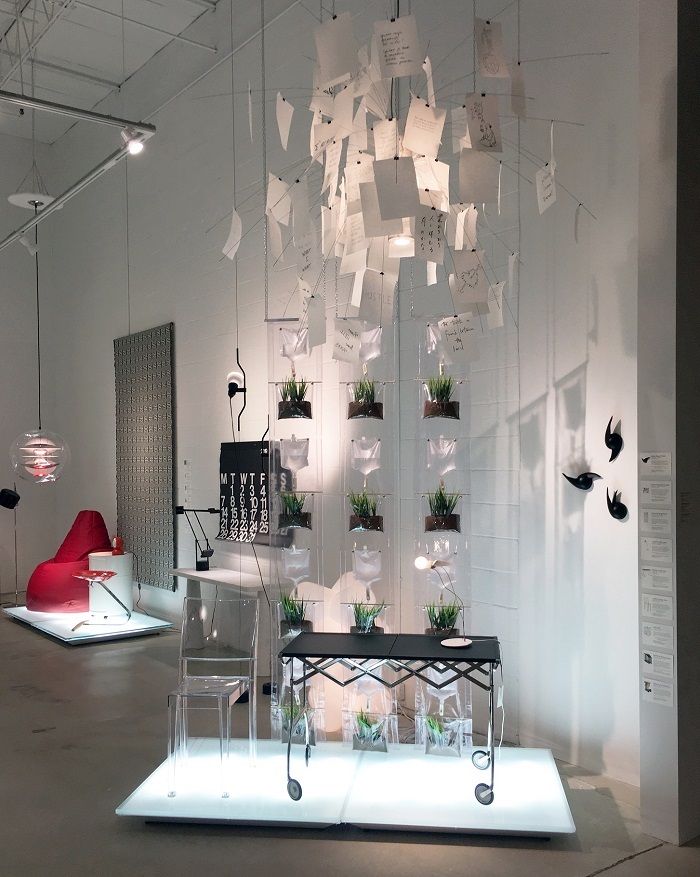
One of the most engaging vignettes within Switch Modern's exhibition, Design Icons of the 20th Century: Included in Museums Around the World, is the last one that explores design in the 1990s - these were often high-concept; many having been informed by new materials and technologies. Here are six designs from this Design Icons vignette that beautifully illustrate this.
High Concept, Intellectual Design:
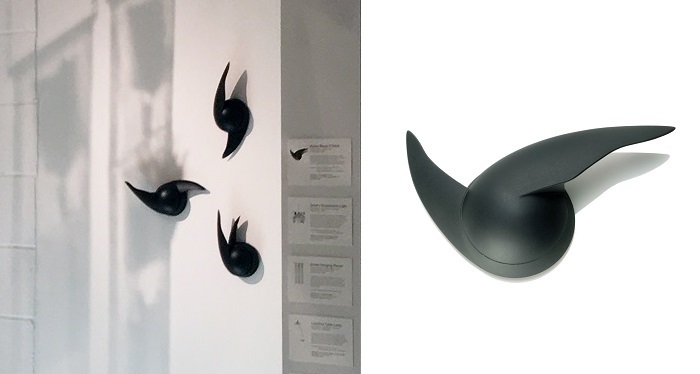
Walter Wayle wall clock, Philippe Starck, Alessi, Italy, 1989.
On the wall are three examples of Philippe Starck's fabulously enigmatic Walter Wayle clock that is as much kinetic sculpture as it is wall clock. Walter Wayle features two sculptural hands (akin to "flippers") that traverse wall space like a clock without numbers. The location of the hands at any particular moment suggests the time without actually denoting it. Walter Wayle is included in the permanent collections of the Museum of Modern Art, New York, and Centre Pompidou, Paris.
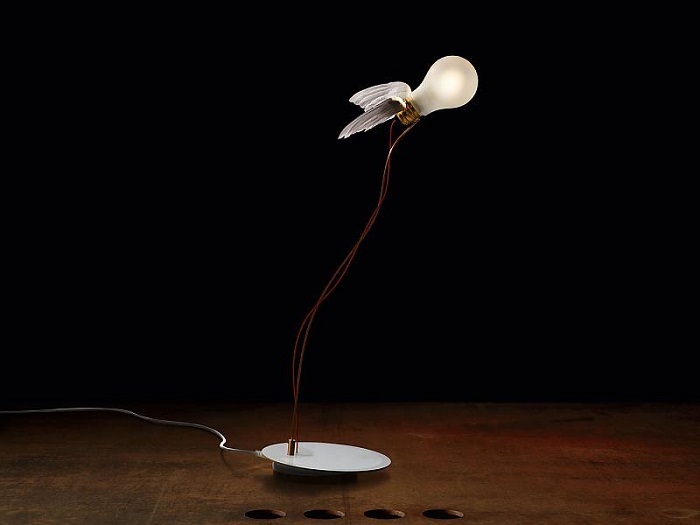
Lucellino table lamp, Ingo Maurer, Ingo Maurer GMBH, Germany, 1992
Lucellino's name is a clever portmanteau - in Italian, "luce" means light and "uccellino" means little bird. Its form is quite literally a light bulb with affixed hand-crafted goose feather wings that have been "tethered" to its thin brass flexible wire support and soldered to its thin red power cord. Originally introduced with an incandescent bulb, Ingo Maurer developed a proprietary LED light source that expertly mimics the original bulb. This commitment to new technology helps make designs like Lucellino infinitely relevant decades after their initial introduction. Lucellino is included in the permanent collections of the Museum of Fine Arts, Boston, and the Philadelphia Museum of Art, Philadelphia.
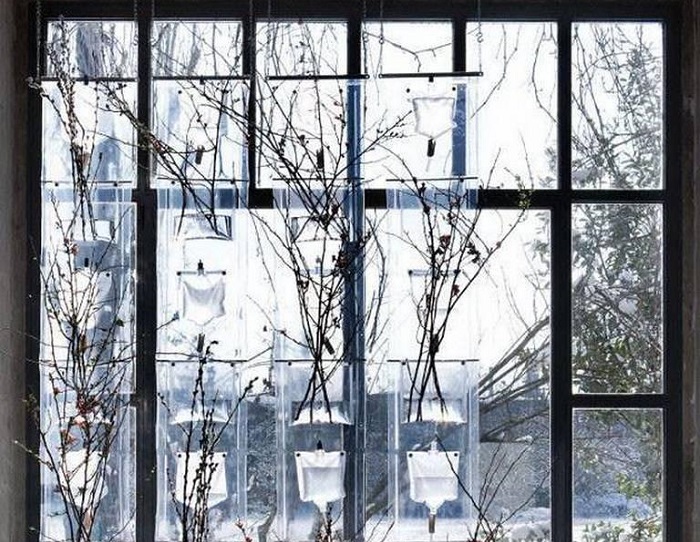
Erbale hanging planting system, Fabio Bortolani, Stefano Maffei, and Walter Becchelli, Driade, Italy, 1995.
Erbale is essentially a vertical planting system that features a long rectilinear panel in transparent PVC that has been fitted with integrated snaps with which to attach both transparent and slightly opaque sacs - four open sacs for plants or flowers and four sacs for dispensing water that loosely resemble IV bags. Atop the panel are slender chains that allow the user to simply hook the panel to a S-shaped hook that screws directly into the ceiling - Erbale's height can be adjusted by using the links within the chain. Four narrow wooden dowels are inserted horizontally above each plant sac that function as cross braces to maintain Erbale's rectilinear shape; the resulting weight of the water, plants, and soil provides stability for the form as it cascades toward the floor or ultimately gently rests upon it. Erbale provides an unexpected aesthetic. As a conceptual piece, it's laden with metaphor... quite literally the compartmentalization of nature into suspended sacs and, consequently, the need to care for such with a "feeding tube." Included: Museum Angewandte Kunst, Frankfurt.
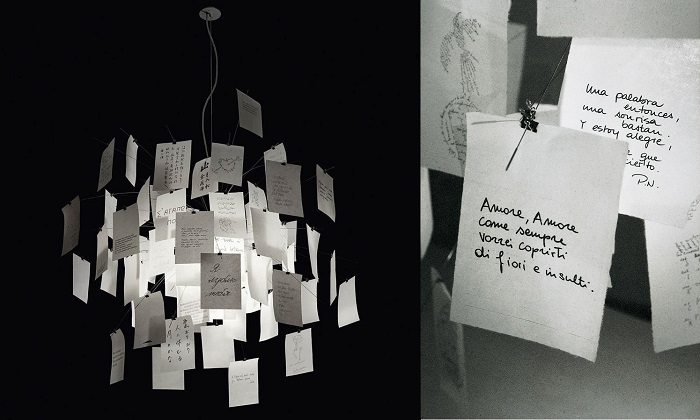
Zettel'z 5 suspension light, Ingo Maurer, Ingo Maurer GMBH, Germany, 1997.
Zettel'z is presented essentially as a "kit" where the designer has provided the "parts" - paper, clips, wire - to ultimately create the diffuser's form. Several standard A6 size paper sheets are printed with drawings and language by Ingo Maurer while others are left intentionally blank - the latter can remain as such or be completed with the user's own language or drawings. Similarly, extra kits of blank paper are available should the user wish to supplant the designer's printed piece with their own. The way in which Zettel'z is assembled along with the paper that its owner ultimately uses ensures that the resulting suspension light is unique having relied heavily upon its user/owner to ultimately determine the lamp's final aesthetic. Zettel'z is included in the permanent collections of the Museum of Modern Art, New York, and the Indianapolis Museum of Art, Indianapolis.
New Materials, New Aesthetics:
Having been a part of many important designs from the 1960s forward, new types of plastic and ways with which to manipulate the material engender new aesthetics in the 1990s.
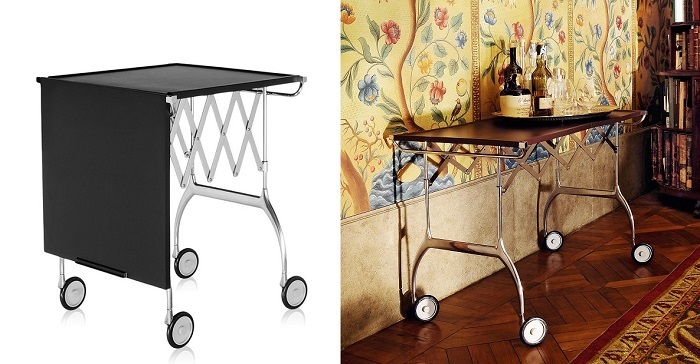
Battista trolley, Antonio Citterio + Glen Oliver Löw, Kartell, Italy, 1991.
The Battista extendable table or trolley is a clever, pragmatic design that provides its user with an impromptu surface for a range of purposes - a mobile bar, dessert cart, or appetizer service. Its accordion style chromed steel base can be extended to accommodate its top in two sections or folded to create a compact footprint for storage. It's an early example of Kartell's creating objects that combine plastic with other materials - Philippe Starck's Dr. Glob chair for Kartell in 1988 is one of the best-known examples of this shift. In the 1990s, plastic finishes tended to be matte rather than glossy - a marked shift from the aesthetics associated with plastic designs from the 1960s and 1970s. Battista is included in the Museum of Modern Art, New York.
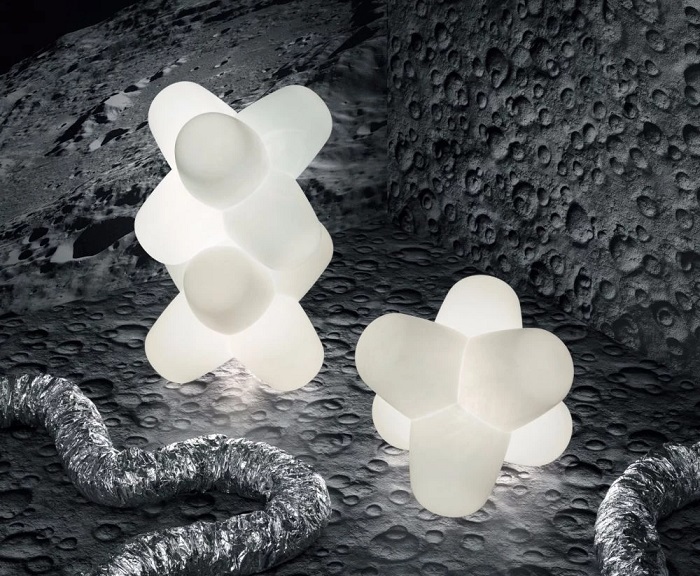
Jack Light floor lamp, Tom Dixon, Tom Dixon, UK, 1994.
Both a floor lamp and a stool, Tom Dixon refers to his award-winning Jack Light as a "sitting, lighting, stacking thing." First produced in 1997, Jack was one of Dixon's early experiments with rotationally molded plastic. The ability to rotationally mold plastic would play a significant role in designs produced from the late 1990s forward. Jack Light is included in the Victoria & Albert Museum, London; the Museum of Fine Arts, Houston; and the Auckland Museum, Auckland.
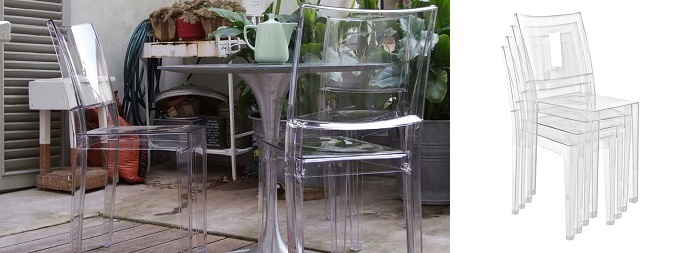
La Marie dining chair, Philippe Starck, Kartell, Italy, 1998.
The first example of a completely transparent chair made from a single polycarbonate mold, La Marie combines essential design with an exceptionally robust, shock-resistant structure. An ingenious combination of lightness and strength, La Marie was the result of painstaking and meticulous research on polycarbonate material. With polycarbonate, an aesthetic similar to glass could be achieved; this would usher in a wide range of new designs in the early 21st century that availed themselves of the transparency and strength associated with the material. La Marie is included in the Museum of Modern Art, New York; the High Museum of Art, Atlanta; and the Centre Pompidou, Paris.
For more information about ordering any of these designs included in Switch Modern's Design Icons exhibition, please contact us at info@switchmodern.com or 404-605-0196.
